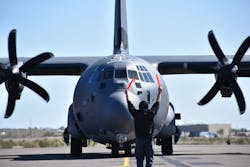With missions at home and abroad, the military have equipment needs that supersede most other industries. The process of military procurement is an entire industry in itself. And while there exist similarities between an airbase and an airport in some measures, the requirements of a military airfield almost always surpass that of a municipal airport’s – even over something as ubiquitous to aviation as the removal of foreign object debris (FOD).
Greg McShane, airfield operations officer for the Marine Corps Air Station Yuma – which operates in conjunction with the Yuma International Airport through a shared-used contract – detailed the differences between the air station’s and airport’s FOD needs.
“They have one FOD sweeper on their side. We have a fleet on our side,” McShane said.
The overlap in equipment and operational needs between civilian aviation and military is most often found at joint-use airports. Though, as McShane explained, even then there is little the two entities share besides land.
“Our roles and responsibilities can be very different. Equipment requirements specific to general aviation and to commercial air carriers can be very different as far as equipment support requirements for military tactical aircraft. We deal with things that they just don't deal with. As a Marine Corps Air Station, it's very common for our aircraft to operate with an ordnance on board and that's not something you're going to see with a general aviation aircraft, a civil aircraft or commercial air carrier. So, a lot of our equipment is very, very specific to the type model aircraft that we support here,” McShane said.
He added that the most common overlap in equipment needs between the air station and airport are with ground support equipment. However, as with their FOD sweepers, what the air station needs to operate exceed what the airport needs.
“Our optical jet aircraft tend to be very FOD-sensitive just because of where the engine intakes are and the material that the aircraft skin is made out of. So, we are very, very sensitive to that. And we have almost daily FOD challenges and are constantly sweeping, cleaning the runway surfaces,” McShane explained. “Not to say that Yuma International is unconcerned about that, but just based on the type of aircraft that they operate, they are less concerned about it. The FOD sensitivities of their aircraft are just simply not as significant as they are to ours. As a result, it's critical that we maintain a very, very clean airfield and runway surfaces because some of our jet aircraft, the smallest pebble can wreak havoc to a single-engine tactical aircraft.”
Though operational and equipment needs differ, the relationship that the Marine Corps Air Station Yuma and Yuma International Airport is one of a kind, as airport director Gladys Brown detailed.
“It is a shared use with an (on station) Joint Use Operating Agreement in which was formed in 2009, and has set precedence.. There is not one property owner of all the land, however the Runways and majority of taxiways are on Department of the Navy property. The air station owns their property and their areas within the airfield and then we’re co-located on the same airfield where the county owns the property itself. We understand which properties we take care of and which taxiways are our primary responsibilities for rehabilitation, reconstruction and maintenance,” Brown said.
She continued, “We together have formed an operating agreement on station, which is very unique. If you look around the nation, a lot of co-located airfields with civilian and military operations, typically, they're required to have a joint use agreement. What we have is an operating agreement between the MCAS Yuma and the airport authority. And so, we have essential services such as ARFF (Aircraft Rescue and Fire Fighting) that they provide through the various letter of agreements (LOAs) and understandings as we operate our separate entities on the same air fields.”
Brown said as a result of sharing space with the air station, most everything at the airport is military-centric, though the airport still has a very active general aviation and commercial operation. Being shared-use with the air station also provides benefits to Yuma International that might not otherwise be available to them. Notably, the airport has four runways, the smallest of which measuring in at 5,700 feet and the longest at 2.4 miles. The size allows for a wide range and type of aircraft to land at the airport, leading to diversification and business development at the airport that would otherwise not be available.
Another advantage to the airport is also one of the few places where Yuma International Airport and the Air Station overlap – the air traffic control tower.
“All of the air traffic control services are provided by Marine Corps Air Station Yuma. They're either uniformed Marines or Department of Defense (DoD) civilians that operate our air traffic control tower, to include our combined en-route radar approach facility. Those ATC services are all provided by us, and as a result, Yuma International provides that general aviation capability on their side of the airfield to include a commercial air carrier operation with American Airlines that the entire community benefits,” McShane said.
“That tower being a DoD, especially if you notice over the last decade, the constant threat to contract towers and the funding and appropriations to those, we're very fortunate that's tied into the air station. And so that cost to have such a phenomenal air traffic control center is to me is one of the advantages to being co-located with a great military installation,” Brown added.
For general equipment usage, though, there is little to no sharing between the two entities.
“We don't use their equipment,” said Brown. “Our fixed-base operator takes care of all of those larger ground service equipment and requirements that our tenant or transient users need. The airport does not borrow from the MCAS Yuma visiting aircraft line (VAL) or from their maintenance groups.”
The Procurement Process
With little overlap between the two, it only makes sense that the Marine Corps Air Station Yuma’s procurement process would differ greatly from Yuma International’s process. Where Yuma International is able to budget and buy like other airports around the nation are, Air Station Yuma is subject to DoD budgets and federal oversight. It can take planning years in advance to make sure the air station has the equipment it needs to complete its missions.
“There are many procurement vehicles in DoD and depending on the dollar amount associated with the specific piece of equipment and what it's used for directs the type of funding and procurement stream that's utilized. There's various thresholds of dollar amounts that drive what procurement source we use,” McShane said.
If, for example, the air station needs a new airfield vehicle, it has procurement through Headquarters Marine Corp for vehicle-type equipment. For ordnance, there’s an Ordnance Program Office and for technology, a Communication Program. It’s very specific lines of procurement, McShane said.
“Depending on what your procuring, you're required to utilize those procurement sources,” McShane continued. “Similar to Yuma International, where they have different funding streams, we also have different funding streams and we have different types of dollars that are coded different ways by Congress. Specific types of dollars are targeted for a specific type of equipment.”
It is critical that the air station is utilizing the right pot of money for the right equipment. This process requires the air station to always be planning for the coming years’ needs.
“Marine aviation is planning years out, and so we utilize the planning information that they push out to the lower S-1s of the Marine Corps, and we produce planning documents, specifically a master plan for the base, that identifies not only current but future requirements. And these go out five, 10, 20 years. We're always looking down the road,” McShane said.
The master plan details construction needs as well.
“When we talk about military construction, or MILCON as we refer to it, and we're talking about new facilities, hangars, that funding process that's mandated by Congress. That's a five-year process because of the dollar amounts involved. We have to have identified those facility requirements long in advance before the funding ever comes to fruition,” McShane added.
Yuma International – which is currently in the process of updating their master plan – and the air station work closely together on their respective documents. Though information captured in each will vary.
“The civilian side ensures that we accommodate our end users and stakeholders, the way we need to and then we make sure in conjunction with cities and counties that we both develop and build our infrastructure based on a plan. So, we ensure that we have communication with them during our planning and development, our master planning and vice versa,” Brown explained.
The two entities then work together when they are within the five miles that they share for development issues, rezoning or usage and compatibility.
“We both work together to ensure that we have a solid, consistent message as we go and evaluate for the development surrounding the airport,” Brown said.
“Although they're two separate plans, a lot of those aspects contain similar information. But again, there's differences in the requirement. Theirs is required to capture specific type of information. Ours is required to catch specific type of information. And that tends to be the differences between the plans. But we're always looking well down the road to try to forecast future requirements as best we possibly can,” McShane added.
Outside of the DoD and Marine Corps channels, the air station can procure equipment locally or online in a limited scope. The Marine Corps provides the air station with a government charge card, with between $2,500 and $3,000 in funds on it and single purchase limitations.
“Procuring office supplies is significantly easier than procuring a major piece of airport equipment,” McShane said.
Getting It Done
Consulting firm Burns & McDonnell has been working on federal and military projects for decades and knows well the standards the military needs out of their work to maintain mission capability.
“The criteria and the requirements are really very different,” said Mark Zimmerman, DoD projects director for Burns and McDonnell, on the difference between civilian and military projects that the firm takes on.
Zimmerman continued, “The U.S. military, they have a set of criteria that used to be Army specifications, Navy specifications, Air Force specifications. They came together years ago and unified those, called them the Unified Facilities Criteria. You need to have a really good understanding of that to really make sure that you can design projects to meet the criteria and requirements of the military.”
As high security as airports are, the security requirements of the military dwarf them, adding another layer to navigate when undertaking projects, said Jason Fuehne, senior project manager at Burns & McDonnell.
“It comes down to each facility, whether it's an Air Force base or a Naval Facilities Engineering Company (NAVFAC) facility, meeting their security requirements,” said Fuehne. “Each situation's a little bit different. It's one of those deals where you have to know the facility that you're working on, what the requirements are in order to have a successful project.”
The branches of the government that Burns & McDonnell has worked with include the Air Force, the Air and Army National Guard, Army, Navy, the National Nuclear Security Administration (NNSA), Department of Energy (DoE) and NASA – as well as crossover weapon systems projects with entities such as the Pantex Plant, the United States’ primary nuclear weapons assembly and disassembly facility.
Often working closely with the FAA on municipal airport projects, Fuehne detailed the difference between working with that federal agency and the military.
“In terms of funding, civilian versus the DoD, the primary thing is that the DoD has a lot less flexibility, from the standpoint of funding. It's set very early on, whereas the FAA can kind of be a little bit more flexible in that aspect,” Fuehne explained. “When we talk about how to manage projects, the DoD has a set of rules. No matter what branch of the military you're working with, each branch has its own overarching rules. If you're talking about the civilian aspects of air, mostly municipal, each airport authority's going to have a way of looking at things. It's a little bit different. It changes your approach, changes how you manage the project and how you approach the design, the budgets, etc.”
A recent project undertaken by the firm was at Wright-Patterson Air Force Base (WPAFB) to evaluate and rehabilitate one runway and three taxiways, replacing nearly 3.5 million square feet of paving.
“Wright-Patterson's going through a number of different programs to update their facilities, update their pavements. With regards to the mission, from our standpoint we were looking at redoing some other taxiways and redoing one of their runways to help them get to the next level. They've got a big runway project that's coming up, and we're basically tasked with trying to upgrade the adjacent pavements to make sure they're ready when the big project comes. The airfield has got some pavements out there that have been there since World War II started. We’re trying to deal with what they have and then bring it up to the criteria for today,” explained Fuehne.
Projects generally begin with the U.S. Army Corps of Engineers (USACE), which branches like the Air Force partner with, who manage the design, supervision and execution of construction. Burns & McDonnell then pursues architect-engineer (A-E) design contracts with the USACE.
“Burns & McDonnell has these A-E contracts with the major Federal design/construction agents, whether it be the Army, or the Air Force, or the Navy. When they get a project, they will issue a design task order. They'll look at their cadre of A-E firms that they have the ability to choose from. They'll select which firm based on the best technical professional qualifications, or has the capacity, or both – a balance of capabilities and qualifications as well as capacity – to execute that design. Then we'll put our proposal together and get our technical staff onboard and move the project forward,” elaborated Zimmerman.
The WPAFB project required a near constant line of communication with the air base and its stakeholders, which is normal for many DoD projects.
“The list of stakeholders is extremely long. When you talk about a civilian airfield, you're really talking with the planning and engineering department, and in some cases maybe the executives of an airport. But the DoD team, you're not working only with the USACE, you're also working with, like the project that we did at Wright-Patterson, it's the Corps of Engineers, it's the Air Force. In some cases, it's local municipalities that are adjacent to the base when you're talking about storm water and things like that,” said Fuehne
The age of facilities that the firm is working on is often challenge.
“You talk about potentially the historical impact of some items and how the facilities and the infrastructure was used back when we were in a major wartime effort. We've talked about unexploded ordinances on site. We’ve had state historical preservation society rules on some of the facilities that we work on. And then we've got materials and soils on sites that are sometimes inadequate for what we're looking to do,” Fuehne said.
And with age comes unknowns, with variables that make military projects unique and exciting in ways that others often can’t.
“It makes the project really cool. Sometimes you're excavating for a project where barracks used to be and suddenly it’s, ‘oh my gosh, there's a septic tank here from 1942.’ It's just kind of different things that you may not run into on a general commercial aviation type project,” Fuehne added.
However, the more common challenge returns to the heightened security.
“Sometimes with these larger projects, the ability to get people as well as construction materials on an installation, because of the heightened security requirements, can be a real challenge,” said Zimmerman.
To alleviate that challenge, sometimes bases will temporarily re-flow their boundaries around a work site to establish an open work environment.
The nature and stringent conditions that come with military projects can be difficult enough for those already in the know to navigate; for those on the outside looking to break into it, the process can seem like a labyrinth.
“One of the things that some folks don't understand is that government contracting does have a set of rules. I know from my personal experience on the commercial aviation side, there's folks that can work at a commercial airport that cannot work for the federal government, because they are not set up appropriately to meet the guidelines that the federal government requires, “ Fuehne explained. “If folks are looking to get into working for the federal government, they've got to make sure they're meeting those requirements. And that's probably somewhat where the difficulty comes.”
Zimmerman added: “The Architecture, Engineering and Construction community is very diverse. There's a lot of very, very small A-E firms within the municipal community area. Whether they have the expertise to actually support a DoD federal military project is probably a little bit of a challenge, if they're not familiar with it. The learning curve can be a little bit steep.
"Then you look at that next level to see if there is there a firm regionally that can address your needs or requirements. That gets a little more difficult once you get outside the boundary of what you would consider your resources. Then there's the national level, which has much more opportunity, much more capability, but then it is also much more complicated,” Zimmerman said.
It’s a sentiment that McShane echoed about the needs at MCAS Yuma.
“As a military installation, a military airport, we're looking for generally very specific capabilities, specific to the type of airport, really based on the type of aircraft that we support. I get contacted fairly regularly about different vendors. And just because they provide equipment or services to one type of airport doesn't necessarily mean that that's a service or piece of equipment that we would require as a military installation. So, I think the best thing that a vendor could do is, or even consultants, is target their audience to those specific requirements,” McShane said.
And when the Marines have a requirement that the industry can’t meet, they create it.
“Sometimes a capability, whether it be a piece of equipment or a service, is so unique that it's really hard to find that capability out there. When it doesn't exist, what we find ourselves doing is going out for proposals for that specific type of capability and it may very well result in a new emerging technology or new capability that just hasn't existed before. Marine aviation continues to change fairly rapidly and so our requirements change,” McShane described.
It Happened in Havasu
On Aug. 1, Havasu Air Center, an FBO located at Lake Havasu City Airport in Lake Havasu City, Ariz., was awarded a Defense Logistics Agency (DLA) energy contract. The Havasu Air Center is co-owned by brothers Dante and Darren Marinelli. The FBO had tried multiple times in the past to get the contract as the airport is used to servicing military aircraft due to its proximity to the Army’s National Training Center (NTC) before winning in the fall.
Dante Marinelli said that while they were never told why they hadn’t received the contract before, this time around he triple-checked to make sure the FBO was in compliance with the military’s needs.
“When they open up a contract for your location the first step is to make sure that you're a 100 percent compliant. Making sure that your trucks, your facility, your quality assurance and everything is up to their spec. Specifically, we did some hot fuel training and some other training, safety and ramp training, to make sure that we were up to speed and ready to go,” Marinelli said.
He added that a key aspect to winning the contract was documentation.
“You might already be doing the procedures, but you might not have it all documented 100 percent. What my lead line manager did was spend a lot of time going back and creating a lot of paper trail for us not only just on procedures for fueling and defueling, but also procedure books for hot fueling techniques, procedures for aircraft specific to what we're seeing with locations for their hot fueling or their pressure points versus their over wings. Devising a system with the airport for parking the aircraft and then making sure we follow through with that every single time that they land so that way we have safe procedures when we're specifically doing hot fueling,” Marinelli said.
The Havasu Air Center ramped up their facilities and bought a handful of more fueling trucks, did research on procedures, which included making sure all of their employees had the proper protective gear. They also constructed a special lounge just for servicemembers that’s open 24/7.
Communication with the military members the FBO found and has set up a new text message system in place, allowing for the military to phone in and get a map texted to them with specific parking instructions.
“That way we can open up a line of communication with the aircraft that's being scheduled. That's helpful to make sure that they have specific instructions as far as parking, location and they get a map literally right on their phone as soon as they hang up with us. It’s something new that we specifically developed to interface with the military for their reservations,” Marinelli explained.
The increase from military has double Havasu Air Center’s fuel output and they’ve hired extra employees to handle the demand, and the FBO makes sure the servicemembers who visit them are taken care of.
“We've doubled the amount of aircraft. Month over month over month we're seeing between 10 and 15 percent gains. So, we feel that what we're doing is obviously taking care of them. We do, even when we do hot fuelings, we'll do go-bags or lunch bags for the crew, if requested. Making sure that they're fed even on quick turns is definitely a positive,” Marinelli said.
Outside of fueling, the contract has also increased the business opportunities.
“Over the last couple of months, we've hosted several groups for extended missions out here which was never happening beforehand. And so, we had a group of Air Force V22s come in and base with us for several weeks of extended training where they would actually base and bring their maintenance and ops people out, which we hosted and took care of,” said Marinelli.







